<< Our Photo Pages >> Dun Aengus - Stone Fort or Dun in Ireland (Republic of) in Co. Galway
Submitted by DrewParsons on Wednesday, 31 January 2018 Page Views: 26792
Multi-periodSite Name: Dun Aengus Alternative Name: Dún AonghasaCountry: Ireland (Republic of) County: Co. Galway Type: Stone Fort or Dun
Nearest Village: Kilronan
Map Ref: L817098
Latitude: 53.125892N Longitude: 9.767958W
Condition:
| 5 | Perfect |
| 4 | Almost Perfect |
| 3 | Reasonable but with some damage |
| 2 | Ruined but still recognisable as an ancient site |
| 1 | Pretty much destroyed, possibly visible as crop marks |
| 0 | No data. |
| -1 | Completely destroyed |
| 5 | Superb |
| 4 | Good |
| 3 | Ordinary |
| 2 | Not Good |
| 1 | Awful |
| 0 | No data. |
| 5 | Can be driven to, probably with disabled access |
| 4 | Short walk on a footpath |
| 3 | Requiring a bit more of a walk |
| 2 | A long walk |
| 1 | In the middle of nowhere, a nightmare to find |
| 0 | No data. |
| 5 | co-ordinates taken by GPS or official recorded co-ordinates |
| 4 | co-ordinates scaled from a detailed map |
| 3 | co-ordinates scaled from a bad map |
| 2 | co-ordinates of the nearest village |
| 1 | co-ordinates of the nearest town |
| 0 | no data |
Internal Links:
External Links:
I have visited· I would like to visit
lichen visited on 11th Oct 2023 - their rating: Cond: 3 Amb: 5 Access: 3
jeffrep visited on 20th Apr 2008 - their rating: Cond: 4 Amb: 5 Access: 3
LeGuMa visited on 1st Jan 2001 - their rating: Cond: 3 Amb: 5 Access: 3 It's very impressive and fascinating with the defense work of sharp pieces of limestone.
DrewParsons davidmorgan have visited here
Average ratings for this site from all visit loggers: Condition: 3.33 Ambience: 5 Access: 3

A fourth (outermost) wall is almost destroyed. A low-lintelled doorway leads in from the N. The innermost citadel (whose massive buttresses are modern) has a fine lintelled entrance, wall-walks, and chambers, and encloses an area roughly 45 metres across.
~ 2.2 km NW of Kilronan is Dun Oghil (Dún Eochla, L 863098), another massive (and over-restored) fort, circular and surrounded by the tiny stonewalled fields that are typical of the West of Ireland.
Piles of stones inside the citadel are the remains of huts, and there are terraces and stairways.
~ 7.4 km WNW of Kilronan is Dun Onaght (Dún Eoghanacht), an almost circular, single-wall fort with terraced rampart and three house-sites.
~ 2.2 km SW of Kilronan is Dun Doocaher (Dún Dubhchathair or the Black Fort), a promontory fort with remains of chevaux-de-frise outside a massive curved rampart cutting across the base of a cliff-girt promontory.
~ 3.5 km WNW of Kilronan, in Oghil is Dermot and Grania’s Bed (Leaba Dhiarmuid agus Gráinne), a fine wedge-tomb with three overlapping roofstones covering a gallery over 2.5 metres long.
~ On the middle island of the Aran group, Inishmaan, is Doon Conor (Dún Chonchúir), also over-restored but very impressive, with terraces, wall-chambers and (restored) hut-sites.
Text by Anthony Weir
Note: A possible link between Atlantic Megaliths and Crane Animism, a new book by Irish Naturalist Lorcán Ó Tuathail, who suggests Dún Aonghasa, in the Aran Islands, may have been deliberately constructed under the migratory path of cranes. More details in the comments on our page
You may be viewing yesterday's version of this page. To see the most up to date information please register for a free account.
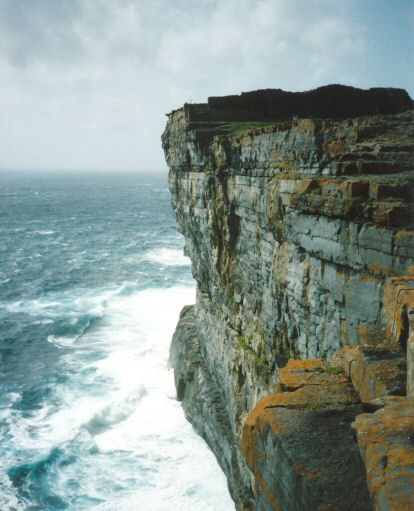
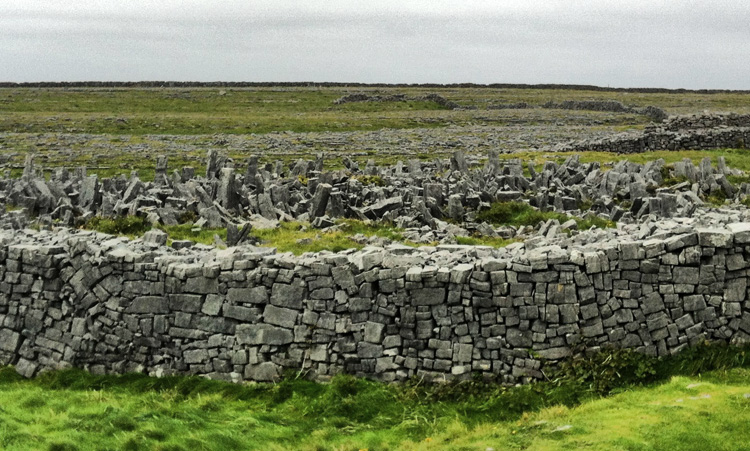
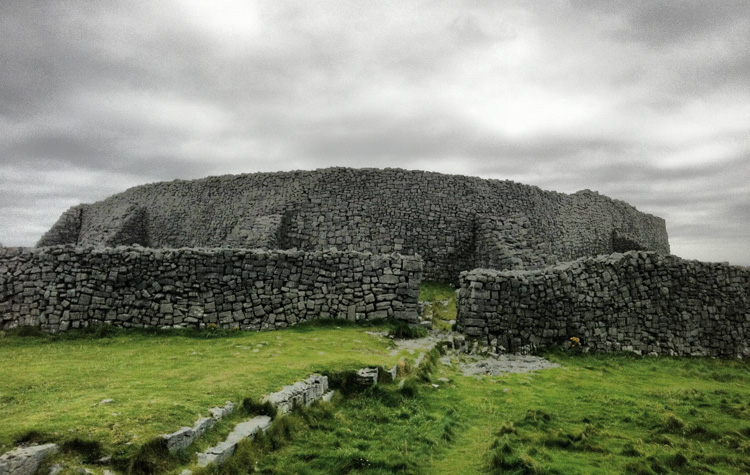
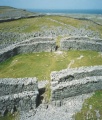
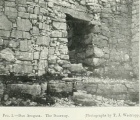
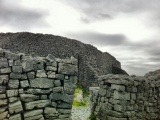

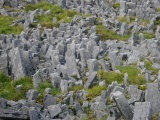
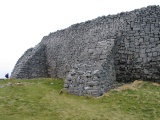
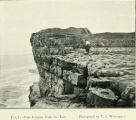
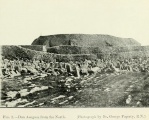
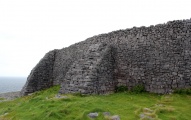
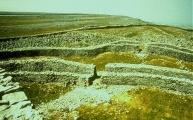

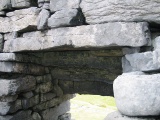
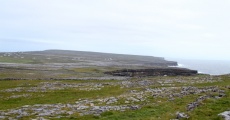

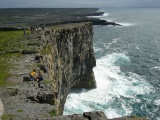
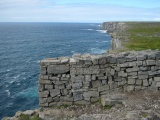
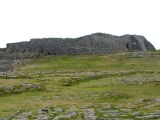
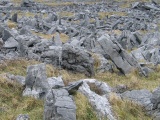
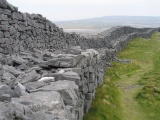
These are just the first 25 photos of Dun Aengus. If you log in with a free user account you will be able to see our entire collection.
Do not use the above information on other web sites or publications without permission of the contributor.
Click here to see more info for this site
Nearby sites
Click here to view sites on an interactive map of the areaKey: Red: member's photo, Blue: 3rd party photo, Yellow: other image, Green: no photo - please go there and take one, Grey: site destroyed
Download sites to:
KML (Google Earth)
GPX (GPS waypoints)
CSV (Garmin/Navman)
CSV (Excel)
To unlock full downloads you need to sign up as a Contributory Member. Otherwise downloads are limited to 50 sites.
Turn off the page maps and other distractions
Nearby sites listing. In the following links * = Image available
938m NE 48° Ogham stone at Kilmurvy* Standing Stone (Menhir) (L8241410412)
1.0km ENE 61° Dún Aengus Inishmore Island Promontory Fort / Cliff Castle
1.7km NNW 341° Dun Eoghanachta* Stone Fort or Dun (L812114)
1.8km NNE 18° Clochan na Carraige* Ancient Village or Settlement (L823115)
2.0km NW 322° Clochan Chambered Cairn
2.3km NNW 344° Na Seacht dTeampaill* Early Christian Sculptured Stone
2.4km NNW 345° High Cross (Teampall Bhreacain)* Ancient Cross
3.3km E 87° Oghil Wedge Tomb* Wedge Tomb (L84980988)
4.5km E 88° Dún Eochla wedge tomb* Wedge Tomb (L8620409853)
4.6km E 89° Dun Eochla* Stone Fort or Dun (L863098)
5.6km E 83° Chiaráin stones* Holed Stone
5.8km ESE 114° Dun Ducathair* Stone Fort or Dun (L870073)
13.2km ESE 111° Dún Chonchúir* Stone Fort or Dun
18.1km ESE 113° O'Brien stone fort Stone Fort or Dun
18.1km NE 35° Oorid Standing Stones (L924245)
21.9km N 356° Lough Scannaimh* Crannog
27.4km ESE 113° Teergonean* Court Tomb (R068985)
30.1km SE 130° St. Brigid's Holy Well* Holy Well or Sacred Spring (R0444489948)
31.9km E 91° Fanmore Midden* Ancient Village or Settlement
34.3km E 86° Caherdoonerish Ring Fort* Stone Fort or Dun
36.5km E 95° Derrynavaha* Wedge Tomb (M1803105466)
36.5km ESE 109° Boghill Centre Modern Stone Circle etc
37.0km SE 129° Calluragh South* Burial Chamber or Dolmen (R101860)
37.7km E 95° Faunarooska Wedge Tomb* Wedge Tomb
39.1km ESE 103° Cahermacnaughten Stone Fort or Dun (M197001)
View more nearby sites and additional images


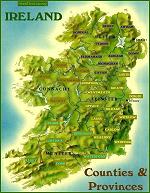
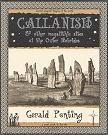
 We would like to know more about this location. Please feel free to add a brief description and any relevant information in your own language.
We would like to know more about this location. Please feel free to add a brief description and any relevant information in your own language. Wir möchten mehr über diese Stätte erfahren. Bitte zögern Sie nicht, eine kurze Beschreibung und relevante Informationen in Deutsch hinzuzufügen.
Wir möchten mehr über diese Stätte erfahren. Bitte zögern Sie nicht, eine kurze Beschreibung und relevante Informationen in Deutsch hinzuzufügen. Nous aimerions en savoir encore un peu sur les lieux. S'il vous plaît n'hesitez pas à ajouter une courte description et tous les renseignements pertinents dans votre propre langue.
Nous aimerions en savoir encore un peu sur les lieux. S'il vous plaît n'hesitez pas à ajouter une courte description et tous les renseignements pertinents dans votre propre langue. Quisieramos informarnos un poco más de las lugares. No dude en añadir una breve descripción y otros datos relevantes en su propio idioma.
Quisieramos informarnos un poco más de las lugares. No dude en añadir una breve descripción y otros datos relevantes en su propio idioma.